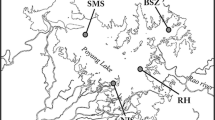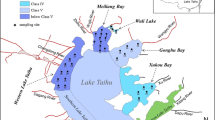Abstract
Purpose
Baiyangdian Lake is located in the core of Xiongan New Area and is the largest freshwater lake in the North China Plain with a variety of habitats. Microorganisms are important drivers of material cycle and energy transport in freshwater ecosystems. To understand the biogeochemical circulations in Baiyangdian Lake, the bacterial community structures and influencing factors of surface sediments among the different habitats were investigated.
Materials and methods
Samples were taken from five areas of Baiyangdian Lake. The concentration of nutrient elements and bacterial community structures was measured.
Results and discussion
The bacterial community structures of different habitats were different and were influenced by the nutrients in surface sediment. Open water areas had the richest abundance of ecological functions, such as phototrophy, sulfur oxidation, sulfite respiration, nitrification, and nitrite respiration. The bacterial community structures among the different habitats were decided by different elements in sediment; sulfur was the key influencing factor of the bacterial community structure in open water; C/N ratio was the key influencing factor of reed marshes; nitrogen and organic carbon were the key influencing factors of river estuary habitat.
Conclusions
The bacterial community structures and ecological functions of surface sediments among habitats were different, and the dominant bacteria played an important role in biogeochemical circulations, especially in the carbon and sulfur cycles of Baiyangdian Lake.





Similar content being viewed by others
References
Balk M, Altinbas M, Rijpstra WI, Sinninghe Damste JS, Stams AJ (2008) Desulfatirhabdium butyrativorans gen. nov., sp. nov., a butyrate-oxidizing, sulfate-reducing bacterium isolated from an anaerobic bioreactor. Int J Syst Evol Microbiol 58:110–115. https://doi.org/10.1099/ijs.0.65396-0
Bižić M, Klintzsch T, Ionescu D, Hindiyeh MY, Günthel M, Muro-Pastor AM, Eckert W, Urich T, Keppler F, Grossart HP (2020) Aquatic and terrestrial cyanobacteria produce methane. Science Advances 6:eaax5343. https://doi.org/10.1126/sciadv.aax5343
Boschker HT, Vasquez-Cardenas D, Bolhuis H, Moerdijk-Poortvliet TW, Moodley L (2014) Chemoautotrophic carbon fixation rates and active bacterial communities in intertidal marine sediments. PLoS One 9:e101443. https://doi.org/10.1371/journal.pone.0101443
Chen Y, Mi T, Liu Y, Li S, Zhen Y (2020) Microbial community composition and function in sediments from the Pearl River Mouth Basin. J Ocean Univ 19:941–953. https://doi.org/10.1007/s11802-020-4225-7
Franklin RB, Mills AL (2003) Multi-scale variation in spatial heterogeneity for microbial community structure in an eastern Virginia agricultural field. FEMS Microbiol Ecol 44:335–346. https://doi.org/10.1016/s0168-6496(03)00074-6
Geist J, Hawkins SJ (2016) Habitat recovery and restoration in aquatic ecosystems: current progress and future challenges. Aquat Conserv Mar Freshw Ecosyst 26:942–962. https://doi.org/10.1002/aqc.2702
Guo W, Pei Y, Yang Z, Chen H (2011) Historical changes in polycyclic aromatic hydrocarbons (PAHs) input in Lake Baiyangdian related to regional socio-economic development. J Hazard Mater 187:441–449. https://doi.org/10.1016/j.jhazmat.2011.01.052
Han X, Schubert CJ, Fiskal A, Dubois N, Lever MA (2020) Eutrophication as a driver of microbial community structure in lake sediments. Environ Microbiol 22:3446–3462. https://doi.org/10.1111/1462-2920.15115
Hu G, Luo X, Li F, Dai J, Guo J, Chen S, Hong C, Mai B, Xu M (2010) Organochlorine compounds and polycyclic aromatic hydrocarbons in surface sediment from Baiyangdian Lake, North China: Concentrations, sources profiles and potential risk. J Environ Sci 22:176–183. https://doi.org/10.1016/s1001-0742(09)60090-5
Huang X, Hu B, Wang P, Chen X, Xu B (2016) Microbial diversity in lake–river ecotone of Poyang Lake, China. Environ Earth Sci 75:965. https://doi.org/10.1007/s12665-016-5473-0
Kallistova AY, Savvichev AS, Rusanov II, Pimenov NV (2020) Thermokarst lakes, ecosystems with intense microbial processes of the methane cycle. Microbiology 88:649–661. https://doi.org/10.1134/s0026261719060043
Klump JV, Fitzgerald SA, Waplesa JT (2009) Benthic biogeochemical cycling, nutrient stoichiometry, and carbon and nitrogen mass balances in a eutrophic freshwater bay. Limnol Oceanogr 54:692–712. https://doi.org/10.4319/lo.2009.54.3.0692
Liang S, Deng J, Jiang Y, Wu S, Zhou Y, Zhu W (2020) Functional distribution of bacterial community under different land use patterns based on FaProTax function prediction. Pol J Environ Stud 29:1245–1261. https://doi.org/10.15244/pjoes/108510
Liu J, Zhang P, Li H, Tian Y, Wang S, Song Y, Zeng G, Sun C, Tian Z (2018) Denitrification of landfill leachate under different hydraulic retention time in a two-stage anoxic/oxic combined membrane bioreactor process: performances and bacterial community. Bioresour Technol 250:110–116. https://doi.org/10.1016/j.biortech.2017.11.026
Liu Y, Chen L, Zhang N, Li Z, Zhang G, Xu Y, Shen Q, Zhang R (2016) Plant-microbe communication enhances auxin biosynthesis by a root-associated bacterium, Bacillus amyloliquefaciens SQR9. Mol Plant-Microbe Interact 29:324–330. https://doi.org/10.1094/MPMI-10-15-0239-R
Liu Y, Wang X, Chen Y, Zhang L, Xu K, Du Y (2020) Anaerobic methane-oxidizing bacterial communities in sediments of a drinking reservoir, Beijing, China. Ann Microbiol 70. https://doi.org/10.1186/s13213-020-01578-5
Lomans BP, van der Drift C, Pol A, Op den Camp HJM (2002) Microbial cycling of volatile organic sulfur compounds. Cell Mol Life Sci 59:575–588. https://doi.org/10.1007/s00018-002-8450-6
Pacesila I (2015) Benthic microbial biomass dynamics in aquatic ecosystems of the Danube Delta. Rom Biotech Lett 20:10496–10503
Pan X, Lin L, Huang H, Chen J (2020) Differentiation of nitrogen and microbial community in the sediments from Lake Erhai, Yunnan–Kweichow Plateau, China. Geomicrobiol J 37:818–825. https://doi.org/10.1080/01490451.2020.1783034
Su X, Cui G, Wang H, Dai Z, Woo NC, Yuan W (2018) Biogeochemical zonation of sulfur during the discharge of groundwater to lake in desert plateau (Dakebo Lake, NW China). Environ Geochem Health 40:1051–1066. https://doi.org/10.1007/s10653-017-9975-9
Sun R, Tu Z, Fan L, Qiao Z, Liu X, Hu S, Zheng G, Wu Y, Wang R, Mi X (2020) The correlation analyses of bacterial community composition and spatial factors between freshwater and sediment in Poyang Lake wetland by using artificial neural network (ANN) modeling. Braz J Microbiol 51:1191–1207. https://doi.org/10.1007/s42770-020-00285-2
Tanaka Y, Tamaki H, Matsuzawa H, Nigaya M, Mori K, Kamagata Y (2012) Microbial community analysis in the roots of aquatic plants and isolation of novel microbes including an organism of the candidate phylum OP10. Microbes Environ 27:149–157. https://doi.org/10.1264/jsme2.me11288
Wan Y, Ruan X, Wang J, Shi X (2019) Spatial and seasonal variations in the abundance of nitrogen-transforming genes and the microbial community structure in freshwater lakes with different trophic statuses. Int J Environ Res Public Health 16:2298. https://doi.org/10.3390/ijerph16132298
Wang B, Liu CQ, Maberly SC, Wang F, Hartmann J (2016) Coupling of carbon and silicon geochemical cycles in rivers and lakes. Sci Rep 6:35832. https://doi.org/10.1038/srep35832
Wang W, Liu W, Wu D, Wang X, Zhu G (2018) Differentiation of nitrogen and microbial community in the littoral and limnetic sediments of a large shallow eutrophic lake (Chaohu Lake, China). J Soils Sediments 19:1005–1016. https://doi.org/10.1007/s11368-018-2090-4
Watanabe T, Kojima H, Takano Y, Fukui M (2013) Diversity of sulfur-cycle prokaryotes in freshwater lake sediments investigated using aprA as the functional marker gene. Syst Appl Microbiol 36:436–443. https://doi.org/10.1016/j.syapm.2013.04.009
Worsfold PJ, Gimbert LJ, Mankasingh U, Omaka ON, Hanrahan G, Gardolinski PC, Haygarth PM, Turner BL, Keith-Roach MJ, McKelvie ID (2005) Sampling, sample treatment and quality assurance issues for the determination of phosphorus species in natural waters and soils. Talanta 66:273–293. https://doi.org/10.1016/j.talanta.2004.09.006
Xiong Y, Guilbaud R, Peacock CL, Cox RP, Canfield DE, Krom MD, Poulton SW (2019) Phosphorus cycling in Lake Cadagno, Switzerland: a low sulfate euxinic ocean analogue. Geochim Cosmochim Acta 251:116–135. https://doi.org/10.1016/j.gca.2019.02.011
Xu S, Lu W, Liu Y, Ming Z, Liu Y, Meng R, Wang H (2017) Structure and diversity of bacterial communities in two large sanitary landfills in China as revealed by high-throughput sequencing (MiSeq). Waste Manage 63:41–48. https://doi.org/10.1016/j.wasman.2016.07.047
Yang W, Yan J, Wang Y, Zhang BT, Wang H (2020a) Seasonal variation of aquatic macrophytes and its relationship with environmental factors in Baiyangdian Lake, China. Sci Total Environ 708:135112. https://doi.org/10.1016/j.scitotenv.2019.135112
Yang Y, Song W, Lin H, Wang W, Du L, Xing W (2018) Antibiotics and antibiotic resistance genes in global lakes: a review and meta-analysis. Environ Int 116:60–73. https://doi.org/10.1016/j.envint.2018.04.011
Yang Y, Yi Y, Zhou Y, Wang X, Zhang S, Yang Z (2020b) Spatio-temporal variations of benthic macroinvertebrates and the driving environmental variables in a shallow lake. Ecol Indic 110:105948. https://doi.org/10.1016/j.ecolind.2019.105948
Zeng R, Zhao Y, Yang Z (2010) Emergy-based health assessment of baiyangdian watershed ecosystem in temporal and spatial scales. Procedia Environmental Sciences 2:359–371. https://doi.org/10.1016/j.proenv.2010.10.041
Zhai X, Piwpuan N, Arias CA, Headley T, Brix H (2013) Can root exudates from emergent wetland plants fuel denitrification in subsurface flow constructed wetland systems? Ecol Eng 61:555–563. https://doi.org/10.1016/j.ecoleng.2013.02.014
Zhang C, Shan B, Zhao Y, Song Z, Tang W (2018a) Spatial distribution, fractionation, toxicity and risk assessment of surface sediments from the Baiyangdian Lake in northern China. Ecol Indic 90:633–642. https://doi.org/10.1016/j.ecolind.2018.03.078
Zhang L, Cheng Y, Gao G, Jiang J (2019a) Spatial-temporal variation of bacterial communities in sediments in Lake Chaohu, a large, shallow eutrophic lake in China. Int J Environ Res Public Health 16:3966. https://doi.org/10.3390/ijerph16203966
Zhang L, Cui J, Song T, Liu Y (2018b) Application of an AQUATOX model for direct toxic effects and indirect ecological effects assessment of polycyclic aromatic hydrocarbons (PAHs) in a plateau eutrophication lake, China. Ecol Model 388:31–44. https://doi.org/10.1016/j.ecolmodel.2018.09.019
Zhang L, Li L, Liu M, Hu Y, Jiang J (2019b) Temporal and spatial variations of bacterial community compositions in two estuaries of Chaohu Lake. J Oceanol Limnol 38:745–758. https://doi.org/10.1007/s00343-019-9096-7
Zhao J, Xu Y, Peng L, Liu G, Wan X, Hua Y, Zhu D, Hamilton DP (2019) Diversity of anammox bacteria and abundance of functional genes for nitrogen cycling in the rhizosphere of submerged macrophytes in a freshwater lake in summer. J Soils Sediments 19:3648–3656. https://doi.org/10.1007/s11368-019-02340-4
Zhou G, Xu X, Qiu X, Zhang J (2019) Biochar influences the succession of microbial communities and the metabolic functions during rice straw composting with pig manure. Bioresour Technol 272:10–18. https://doi.org/10.1016/j.biortech.2018.09.135
Zhu H, Liu XG, Cheng SP (2020) Phytoplankton community structure and water quality assessment in an ecological restoration area of Baiyangdian Lake, China. China. Int J Environ Sci Technol. https://doi.org/10.1007/s13762-020-02907-6
Funding
This work was supported by the Major Science and Technology Program for Water Pollution Control and Treatment (2018ZX07110004).
Author information
Authors and Affiliations
Corresponding author
Ethics declarations
Conflict of interest
The authors declare no competing interests.
Human and Animal Rights and Informed Consent
The article does not contain any studies with human participants or animals.
Additional information
Responsible editor: Haihan Zhang
Publisher’s note
Springer Nature remains neutral with regard to jurisdictional claims in published maps and institutional affiliations.
Supplementary Information
ESM 1
(DOCX 4404 kb)
Rights and permissions
About this article
Cite this article
Chen, J., Wu, J., Liu, M. et al. Bacterial community structure in the surface sediments of different habitats of Baiyangdian Lake, Northern China: effects of nutrient conditions. J Soils Sediments 21, 1866–1874 (2021). https://doi.org/10.1007/s11368-021-02901-6
Received:
Accepted:
Published:
Issue Date:
DOI: https://doi.org/10.1007/s11368-021-02901-6




